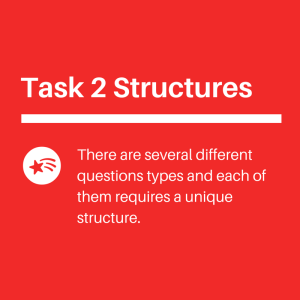Problem Solution Essay
This lesson on how to write a problem solution essay will:
- discuss common mistakes;
- show you how to analyse the question;
- show you how to think of ideas;
- give you a structure that can be used again and again on all problem solution IELTS essays;
- describe how to write an introduction, main body paragraphs and conclusion; and
- give you a full band 9 sample answer.
Problem/solution questions are one of the most common IELTS Writing Task 2 questions on the academic paper. Despite being very common, many students fail to do well in these questions. This post will look at some of the most common mistakes and then take you through how to answer these questions step-by-step.
Common Mistakes
- The most common mistake for problem solution essays is not expanding on your ideas and instead simply listing lots of problems and solutions. The examiner does not want a list of all the problems and solutions you can think of, and please don’t do this in the exam. Instead, if you look at how the exam is marked, the examiner wants you to pick one or two problems and solutions and then expand on them with explanations and examples. More on how to do this below.
- Another common mistake is writing about problems and solutions that are not directly linked to the question. You should be like a sniper when answering the question and only give very specific ideas rather than ideas that generally talk about the overall issue. This has a lot to do with how you identify keywords and micro-keywords in the questions which we will look at below.
- Lots of people think of good ideas for problems and then fail to link their solutions to these problems. Each problem should have a solution directly linked to it, or in other words, it should solve the actual problem.
- Finally, some candidates think of really good problems and solutions that answer the question properly and then expand their answers with explanations and examples, but they talk too generally. Instead, you should be thinking of specific examples and explanations. We will look at how to avoid this below.
Analysing the Question
This is one of the most crucial parts of answering any IELTS writing question. If you don’t take the time to think properly about what the examiner is asking you to do, then it is very difficult to answer the question correctly.
We analyse the question by thinking about three things:
- keywords
- micro-keywords
- action words
Keywords are the words that tell us what the general topic is.
Micro-keywords identify which part of the general topic the examiner wants you to discuss. They often give an opinion, qualify the statement or talk about a sub-category of the bigger general topic.
Action words tell us what the examiner wants us to do.
Problem Solution Sample Essay
Global warming is one of the biggest threats humans face in the 21st Century, and sea levels continue to rise at alarming rates.
What problems are associated with this, and what are some possible solutions?
If we look at this question, we can see that the keywords are ‘global warming‘. This is our general topic. We will write about this, but we cannot write about any problems associated with global warming. If we do this, we have not answered the question properly. We, therefore, need to look at the micro-keywords.
The micro-keywords are ‘humans‘ and ‘sea level rise‘. So instead of writing just about the huge topic of global warming and any problems associated with that (such as increased storms, extinction of certain animals, erosion of soil), we have to talk about how particularly sea level rises will affect humans. If we talked about the problems affecting the ‘planet’ or ‘animals’ or the ‘atmosphere’, we would not be answering the question.
The action words are problems and solutions. Our task is, therefore, to write about that and only that. It does not ask our opinion about the disadvantages, advantages, or causes, just the problems and solutions. If we discussed the causes of sea level rise, we would not be answering the question.
For more information, go to effectively analyse an IELTS question.
How to Think of Ideas
Now that we know exactly what the question is asking us to do, we need to think of specific and relevant ideas. There are many strategies for thinking of ideas for IELTS task 2 questions TO THINK OF IDEAS FOR IELTS WRITING TASK 2 but for problem-solving questions; I like to use something called the ‘coffee shop method’.
Instead of brainstorming or mind-mapping- which take too much time and lead to irrelevant ideas in my opinion- you should pretend you are in a coffee shop with a friend and they have just asked you a simple question. In this case, it would be “What are the problems and solutions associated with sea level rise on humans?”
If you were talking to a friend about this, I’m sure you would have no problem thinking of at least 2 or 3 problems and solutions. This method takes you out of an exam situation and puts your mind into a more relaxed environment. Try it and see. If you don’t like it, try one of my other methods.
There are several problems and solutions, including:
Problem: flooding of people’s homes and businesses
Solution: build flood barriers or move to higher areas
Problem: loss of agricultural land and starvation
Solution: switch to more suitable crops
Problem: displacement of millions of people
Solution: move people in a planned and orderly way before the floods
Problem: groundwater undrinkable
Solution: build desalination plants
As you can see, I didn’t think of lots of problems and then lots of solutions. For each problem, you should think of a solution that directly solves this problem.
You now have lots of ideas, but now you must decide which ones to use. I always tell my students to pick the ones they know most about, i.e. that they can explain and give relevant examples.
Structure
I advise my students to use a basic four-paragraph structure with all problem solution IELTS essays. Your four paragraphs should look something like this:
Paragraph 1- Introduction
Paragraph 2- Problems
Paragraph 3- Solutions
Paragraph 4- Conclusion
At a sentence level, your structure should look like this:
Introduction
1- Paraphrase question
2- Outline sentence
Problem
3- State problems
4- Explain first problem
5- Explain second problem
6- Example of second problem
Solution
7- State solutions
8- Explain solution to first problem
9- Explain solution to second problem
10- Example of solution to second problem
Conclusion
Sentence 11- Summary of main points in paragraphs 2 and 3
For more structures, check out our IELTS task 2 structures guide.
Now let’s look at each paragraph in more detail.
Introduction
The introduction will have two sentences: a paraphrase of the question and an outline statement.
Paraphrasing is simply saying the sentence again with different words but with the same meaning. We can do this by using synonyms and/or changing the order of the words.
Question- Global warming is one of the biggest threats humans face in the 21st Century, and sea levels continue to rise at alarming rates.
Paraphrased- Climate change is among the principal dangers facing people this century, and ocean levels are increasing dramatically.
As you can see above, I have used synonyms to change the words of the questions, but it still has the same meaning. The examiner will look for your ability to do this in the exam, so practising this skill is a good idea.
Our outline sentence is next, which tells the examiner what they will read in the rest of the essay. This makes it very clear to the examiner and makes the rest of the essay much easier to understand. You will, therefore, gain marks for coherence and cohesion.
Our outline sentence should look something like this:
This essay will first suggest that the biggest problems caused by this phenomenon are the loss of land and the flooding of homes and then argue that pollution reduction and building flood protection are the most viable solutions.
Our introduction will, therefore, look like this:
Climate change is among the principal dangers facing people this century, and ocean levels are increasing dramatically. This essay will first suggest that the biggest problems caused by this phenomenon are the loss of land and the flooding of homes and then argue that pollution reduction and building flood protection are the most viable solutions.
It should be noted that this introduction does not contain a thesis statement. This is because this particular question does not ask us for our opinion. However, IELTS problem solution questions sometimes do ask you for your opinion, and you should then include a thesis statement.
Problems Paragraph
Our problems paragraph will have this structure:
Sentence 1- State problems
Sentence 2- Explain first problem
Sentence 3- Explain second problem
Sentence 4- Example of second problem
State problems: The foremost problems caused by climbing sea levels are that land is being lost and peoples’ residences are often flooded.
Now that we have stated the problems, we must explain these. You should always consider your audience to be someone with no specialist knowledge in this area, and you, therefore, need to explain what everything means. Don’t assume that the IELTS examiner is educated and knows what you are talking about. These assumptions will stop you from writing what you need.
Explain first problem: As water levels rise, low-lying land is submerged, and many countries become smaller.
Explain second problem: Furthermore, millions of people worldwide live in coastal areas, and if the sea rises by even a few feet, they are inundated with water and lose their property.
Now we must give an example of what we are talking about. When we give an example, it should be as specific as possible.
An example of a very general example would be:
Lots of people in the world have experienced floods recently.
This is far too general to be considered a good example.
Example: The devastation brought about by this was clear for all to see during the 2011 Tsunami in Japan, in which millions of people were displaced.
This example is much more specific. Stating a place and/or date can help you make your examples more specific.
Our second paragraph will look like this:
The foremost problems caused by climbing sea levels are that land is being lost and people’s residences are often flooded. As water levels rise, low-lying land is submerged, and many countries become smaller. Furthermore, millions of people worldwide live in coastal areas, and if the sea rises by even a few feet, they are inundated with water and lose their property. This devastation was clear for all to see during the 2011 Tsunami in Japan, in which millions of people were displaced.
Now we must move on to our solutions.
Solutions Paragraph
Our solutions paragraph will have this structure:
Sentence 1- State solutions
Sentence 2- Explain solution to first problem
Sentence 3- Explain solution to second problem
Sentence 4- Example of solution to second problem
State solutions: Possible solutions to these problems would be to reduce the amount of pollution created and build flood barriers.
We now need to explain how our solution will help solve the problem. Again, do not assume that the examiner has any specialist knowledge of this topic, so you need to explain what you mean.
Explain first solution: If each person reduces their carbon footprint, the negative effects on the environment will be reduced, which will mean that the water level will stop rising.
Explain second solution: Furthermore, flood defences, such as dikes, dams, and floodgates, could be built along coasts and waterways, thereby stopping the water from reaching populated areas.
Example: The Netherlands is one of the most populated areas in the world and one of the most vulnerable to flooding. They have successfully employed various flood defence systems.
Our whole solutions paragraph will look like this:
Possible solutions to these problems would be to reduce the amount of pollution being created and to build flood barriers. If each person reduces their carbon footprint, the negative effects on the environment will be reduced, which will mean that the water level will stop rising. Furthermore, flood defences, such as dikes, dams, and floodgates, could be built along coasts and waterways, thereby stopping the water from reaching populated areas. The Netherlands is one of the most populated areas in the world and also one of the most vulnerable to flooding, and they have successfully employed various flood defence systems.
We have now answered the question and need to sum up what we have said in the conclusion.
Conclusion
The conclusion should have no new ideas but instead should list the main points from the previous two paragraphs. You can also use synonyms in this paragraph to avoid repetition.
Conclusion: To conclude, stemming the rising tides caused by increasing global temperatures is one of the foremost challenges we face, and it will ultimately lead to some countries losing landmass and many of the world’s cities being left underwater, but possible solutions could be to protect our environment and to utilise the flood prevention techniques already used by countries like Holland.
Our whole conclusion for this problem solution essay will look like this:
To conclude, stemming the rising tides caused by increasing global temperatures is one of the foremost challenges we face, and it will ultimately lead to some countries losing landmass and many of the world’s cities being left underwater, but possible solutions could be to protect our environment and to utilise the flood prevention techniques already used by countries like Holland.
Problem and Solution Sample Essay
Here is the whole essay:
Global warming is one of the biggest threats humans face in the 21st Century, and sea levels continue to rise at alarming rates.
What problems are associated with this, and what are some possible solutions?
Climate change is among the principal dangers facing people this century, and ocean levels are increasing dramatically. This essay will first suggest that the biggest problems caused by this phenomenon are the loss of land and the flooding of homes and then argue that pollution reduction and building flood protection are the most viable solutions.
The foremost problems caused by climbing sea levels are that land is being lost and peoples’ residences are often flooded. As water levels rise, low-lying land is submerged and many countries become smaller. Furthermore, millions of people all over the world live in coastal areas, and if the sea rises by even a few feet, they are inundated with water and lose their property. The devastation brought about by this was clear for all to see during the 2011 Tsunami in Japan, in which millions of people were displaced.
Possible solutions to these problems would be to reduce the amount of pollution being created and to build flood barriers. If each person reduces their carbon footprint, the negative effects on the environment will be reduced and this will mean that the water level will stop rising. Furthermore, flood defences, such as dikes, dams, and floodgates, could be built along coasts and waterways, thereby stopping the water reaching populated areas. The Netherlands is one of the most populated areas in the world and also one of the most vulnerable to flooding and they have successfully employed various flood defence systems.
To conclude, stemming the rising tides caused by increasing global temperatures is one of the foremost challenges we face and it will ultimately lead to some countries losing landmass and many of the worlds’ cities being left underwater, but possible solutions could be to protect our environment and to utilise the flood prevention techniques already used by countries like Holland.
I hope this post helps you with IELTS problem solution essays, and if you have any questions, please comment below.
Next Steps
If you found this lesson useful and it has helped you write a problem solution essay, you should also check out our lessons on task 2 opinions essays, discussion essays and advantages and disadvantages essays.
Do you need me to correct your essays and give you feedback on them? Check out our essay correction service.
The best way to keep up to date with posts like this is to like us on Facebook. There are also lots of practice activities for you to do on the Facebook page.







